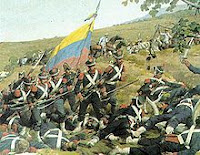 |
| Juan Pedro López |
Artifact 2
Visual Artists of Venezuela
I chose to research the topic of visual arts in Venezuela Venezuela
One of the earliest visual artists of Venezuela Venezuela
of the country’s greatest painters (Lopez, n.d.)
 |
| Martin Tovar y Tovar |
Martin Tovar y Tovar (1827-1902) is generally classified as an early modern realist. After studying under several artists in Caracas , Madrid , and Paris Venezuela
By the middle 19th century, Venezuelan painters and sculptors joined a new art movement causing a stir in Paris Valencia , went to Paris
 |
| Arturo Michelena |
 |
| Emilio Boggio Self Portrait |
 |
| Armando Reveron |
While Claude Monet and Camille Pissarro were known to be influences on Boggio, (Emilio Boggio, n.d.) Reverón who studied in Spain Venezuela
 |
| Alejandro Otero |
The mid-20th Century artists, Alejandro Otero (1921-1990), Jesús Soto (1923-2005), and Carlos Cruz-Diéz (1923- ) are primarily known for their work in kinetic art—sculptures with moving parts. Otero abandoned painting to focus on civic sculptures, receiving commissions for public art in many American cities. One of them, called Delta Solar, was installed at the Air and Space Museum in Washington
Carlos Cruz-Diéz is internationally recognized with works of kinetic and op art and is one of the most important artists to come out of Venezuela Venezuela as well as Europe . In 1997, The Carlos Cruz-Diéz Print and Design Museum was opened in Caracas Paris
______________________
One of the things I’ve noticed about Venezuelan artists is how over the course of years, their work has gravitated from being influenced by the politics of religion as well as the independence movement within the Spanish culture to a more apolitical approach to expression.
The work of these Venezuelan artists reflects the changing subject matter, styles and techniques of the last 400 years in Spanish and European art. From the religious work of López to the public art installations of both Soto and Cruz-Diéz, from the Baroque 18th century to the op art and sculpture of today, Venezuelan artists have developed their own techniques, using their own landscapes and subject matter. Today their Spanish academies, design centers, and museums exist to further the development of new artists as well as to contribute to an international body of work. Their work today seems very separate from the strongly political nature of Venezuelan culture today, especially under the leadership of President Hugo Chavez.
 |
| Marlins Stadium Walkway with Cruz-Diéz |
I have enjoyed learning about all these artists and having a chance to view some of their work, with a few examples shown here. I had no idea that a number of public art installations in the US
Reference List
Alejandro Otero (n.d.). Wikipedia. Retrieved October 7, 2012 from http://en.wikipedia.org/wiki/Alejandro_Otero.
Armando Reveron (n.d.). Wikipedia. Retrieved October 7, 2012 from http://en.wikipedia.org/wiki/Armando_Rever%C3%B3n.
Arturo Michelena (n.d.). Wikipedia. Retrieved October 7, 2012 from http://en.wikipedia.org/wiki/Arturo_Michelena.
Carlos Cruz-Diez (n.d.). Atelier Cruz-Diez. Retrieved October 8, 2012 from http://www.cruz-diez.com/media_files/file/Cruz-Diez_CV_Eng_Summary.pdf.
Columbia, Ecuador, Panama, and Venezuela. (2009) World and Its Peoples: the
Emilio Boggio (n.d.). Artfact. Retrieved October 7, 2012 from http://www.artfact.com/artist/boggio-emilio-gv7lp5fols .
Emilio Boggio (n.d.) Wikipedia. Retrieved October 9, 2012 from
Juan Pedro Lopez (n.d.). artexperts.com Retrieved October 7, 2012 from http://www.artexpertswebsite.com/pages/artists/lopez.php.
Martin Tovar y Tovar (2003). Artfact. Retrieved October 7, 2012 from http://www.artfact.com/artist/y-tovar-martin-tovar-rlyw2kacs9.

I enjoyed all of the information that was included in this artifact. I did like the pictures as well, they helped to emphasis the entire artifact. I do not know how you got the ads in your blog, but I would try to get rid of them if possible.
ReplyDelete